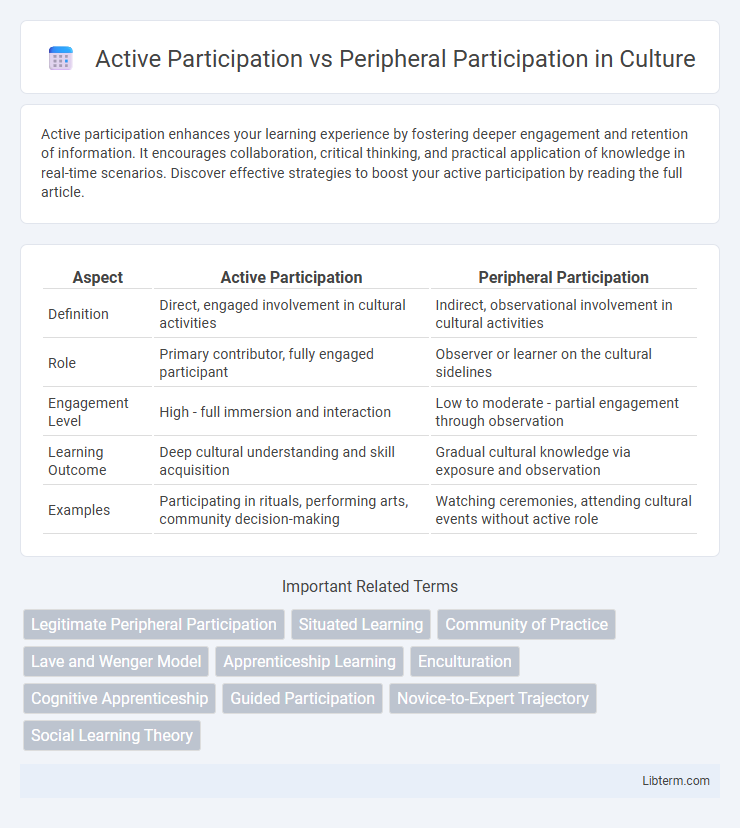Active participation enhances your learning experience by fostering deeper engagement and retention of information. It encourages collaboration, critical thinking, and practical application of knowledge in real-time scenarios. Discover effective strategies to boost your active participation by reading the full article.
Table of Comparison
| Aspect | Active Participation | Peripheral Participation |
|---|---|---|
| Definition | Direct, engaged involvement in cultural activities | Indirect, observational involvement in cultural activities |
| Role | Primary contributor, fully engaged participant | Observer or learner on the cultural sidelines |
| Engagement Level | High - full immersion and interaction | Low to moderate - partial engagement through observation |
| Learning Outcome | Deep cultural understanding and skill acquisition | Gradual cultural knowledge via exposure and observation |
| Examples | Participating in rituals, performing arts, community decision-making | Watching ceremonies, attending cultural events without active role |
Defining Active and Peripheral Participation
Active participation involves direct engagement in a task or activity, characterized by hands-on involvement and conscious decision-making, leading to immediate contribution and influence. Peripheral participation refers to a more observational or indirect role, where individuals engage by watching, listening, or assisting, gaining knowledge and experience without full responsibility. Understanding the distinction between active and peripheral participation is essential in contexts like learning environments and workplaces to optimize skill development and inclusion.
Theoretical Foundations: Key Concepts Explained
Active participation involves individuals engaging directly and intentionally in community practices, contributing to learning through hands-on involvement and meaningful interaction. Peripheral participation, a concept introduced by Lave and Wenger in Situated Learning Theory, describes newcomers' gradual entry into a community by observing and performing low-risk tasks, which facilitates legitimate participation over time. Both concepts emphasize the social context of learning, highlighting how identity and competence develop through varying levels of engagement within communities of practice.
Characteristics of Active Participation
Active participation involves direct engagement, contributing ideas, questions, and feedback in discussions or activities, which enhances learning outcomes and retention. Participants demonstrate initiative, express opinions confidently, and collaborate effectively with peers, reflecting higher cognitive involvement and motivation. This level of interaction fosters deeper understanding and promotes skill development through continuous, meaningful exchanges.
Traits of Peripheral Participation
Peripheral participation involves observing and gradually absorbing the cultural norms and practices within a community without direct or dominant involvement. Traits include limited engagement, reliance on passive learning, and a focus on building understanding before assuming active roles. This approach enables newcomers to develop competence and confidence over time, facilitating smoother integration and deeper contextual awareness.
Benefits of Active Engagement in Learning
Active participation in learning enhances cognitive retention and fosters critical thinking skills by engaging students directly with the material. It promotes deeper understanding through hands-on activities and meaningful discussions, which strengthen neural connections related to the subject matter. This engagement also increases motivation and encourages the development of communication and collaboration skills essential for academic and professional success.
When Peripheral Participation is Advantageous
Peripheral participation is advantageous in environments where learners gradually build confidence and competence by observing experienced members before engaging directly. This approach allows newcomers to absorb contextual knowledge, norms, and practices without the pressure of immediate full participation. It fosters a supportive learning curve, enhancing skill acquisition and social integration within communities of practice.
Factors Influencing Participation Levels
Participation levels in communities are influenced by individual motivation, social context, and accessibility of resources. Active participation often correlates with personal interest, perceived benefits, and strong social ties, while peripheral participation is shaped by limited time, lower commitment, or observational learning needs. Environmental factors such as ease of access, community inclusivity, and effective communication channels also play critical roles in determining engagement intensity.
Transitioning from Peripheral to Active Involvement
Transitioning from peripheral to active participation involves increasing engagement through meaningful contributions in community or organizational activities. This shift requires cultivating trust, acquiring relevant knowledge, and building relationships that encourage proactive involvement. Effective strategies include mentoring, gradual responsibility increases, and fostering environments that support learning and collaboration, which collectively enhance commitment and integration.
Strategies for Encouraging Active Participation
Strategies for encouraging active participation include creating interactive environments where learners feel safe to express ideas and engage in discussions. Incorporating collaborative tasks and real-world problem-solving activities promotes deeper cognitive involvement compared to passive observation. Providing timely feedback and fostering a sense of community enhances motivation and shifts participants from peripheral to active roles in learning processes.
Impacts on Group Dynamics and Learning Outcomes
Active participation enhances group dynamics by fostering engagement, collaboration, and immediate feedback among members, which leads to improved critical thinking and knowledge retention. Peripheral participation allows individuals to observe and absorb group interactions passively, supporting gradual learning and socialization within the community of practice. The balance between these participation modes influences learning outcomes by combining direct involvement with contextual understanding, facilitating both skill acquisition and integration into the group culture.
Active Participation Infographic

 libterm.com
libterm.com